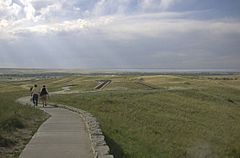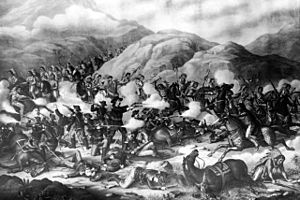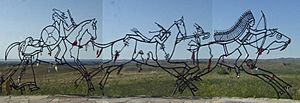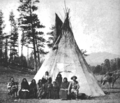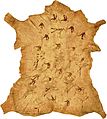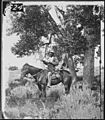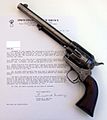Battle of the Little Bighorn facts for kids
Quick facts for kids Battle of the Little Bighorn |
|||||||
|---|---|---|---|---|---|---|---|
| Part of the Great Sioux War of 1876 | |||||||
 The Custer Fight by Charles Marion Russell |
|||||||
|
|||||||
| Belligerents | |||||||
| Commanders and leaders | |||||||
| Units involved | |||||||
| Irregular military | 7th Cavalry Regiment | ||||||
| Strength | |||||||
| 1,500–2,500 warriors | ~700 cavalrymen and scouts | ||||||
| Casualties and losses | |||||||
|
|
||||||
| 10 Non-combatant natives killed | |||||||
The Battle of Little Bighorn has several names. The Lakota and other Plains Indians call it the Battle of the Greasy Grass. Americans call it Custer's Last Stand. The battle was between combined forces of the Lakota, Northern Cheyenne, and Arapaho tribes and the 7th Cavalry Regiment of the United States Army. It took place during the Great Sioux War of 1876. The battle was fought along the Little Bighorn River in the Crow Indian Reservation in southeastern Montana Territory on June 25–26, 1876.
The battle was led by several Native American war leaders including Crazy Horse and Chief Gall. Sitting Bull (Tȟatȟáŋka Íyotake) had a vision of the Native American victory before the battle. The Native American tribes were strong and fought well. They easily defeated the U.S. soldiers.
The U.S. 7th Cavalry, a force of 700 men, suffered a major defeat while under the command of Lieutenant Colonel George Armstrong Custer (formerly a brevetted major general during the American Civil War). Five of the 7th Cavalry's twelve companies were annihilated and Custer was killed. Two of his brothers, a nephew, and a brother-in-law were also killed. As a result of the battle, 268 people died and 55 were severely wounded (six died later from their wounds), including four Crow Indian scouts and at least two Arikara Indian scouts.
Little Bighorn Battlefield National Monument honors those who fought on both sides.
Contents
Prelude to battle
In 1868, many Lakota, Northern Cheyenne, and Arapaho tribal leaders signed the Treaty of Fort Laramie. In this treaty, the U.S. government agreed to set aside a portion of land in South Dakota, including the Black Hills, for the Native American tribes. This area was called the "Great Sioux Reserve." It was meant to keep white settlers and Native American tribes separate. The tribes thought they would finally be left alone. However, gold was discovered in the Black Hills. The U.S. government tried to buy the land, but the Native Americans would not sell it because it was sacred to them. The U.S. government decided that since the tribes would not sell the land, it would call the tribes "hostile" and send soldiers to force them out of the Black Hills.
Military officials planned an attack that would split into three parts. Brig. Gen. George Crook moved north from Fort Fetterman in Wyoming toward the Powder River area. Col. John Gibbon's infantry and a group of Gatling guns marched east from Fort Ellis in western Montana. The third column under Brig. Gen. Alfred Terry, marched westward from Fort Abraham Lincoln in the Dakota Territory.
Lt. Col. Custer led the largest wing of Terry's troops. They arrived near the Little Bighorn River in what is now the state of Montana, on the night of June 24. The rest of Terry's column was marching toward the mouth of the Little Bighorn.
Reno's attack
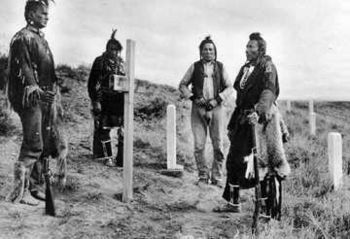
Custer received a warning from Crow Indian scouts (who were helping the U.S. Army) that there was a large encampment of Indians nearby. Despite this warning, Custer decided to attack. On June 25, he divided his regiment into four groups and moved forward. He thought the Indians would flee when they saw soldiers coming.
The first battalion to attack was commanded by Major Marcus Reno. His regimen shot at the Indians from a long distance, and Reno realized that his soldiers would be killed if he moved forward to attack the encampment. Custer, who had promised support, did not send any, and Reno and his troops retreated to the nearby woods. They headed up the river toward the bluffs on the other side. The Indians followed and killed many of Reno's men.
Custer's fight
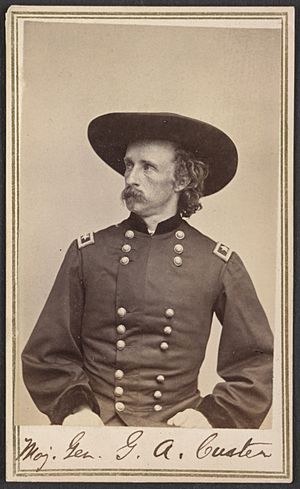
Custer rode along the bluffs and down into a drainage called Medicine Tail Coulee, which led to the river. It is unclear whether he attacked the Indians or they attacked him, but the two forces fought a battle. The Indians from the Reno attack had joined forces and greatly outnumbered Custer and his men. Within two to three hours, Custer and all his men were killed. Stories about the last moments of Custer's forces are not all exactly the same, but all agree that Crazy Horse personally led one of the large groups of Lakota who overwhelmed the cavalrymen.
Aftermath
After their fight with Custer finished, the Lakota and Northern Cheyenne came back to attack the remaining soldiers under Benteen and Reno. U.S. forces under Terry approached from the north and the Indians moved south.
Custer's body was found at the top of the hill where the large obelisk (a monument for the Battle of Little Bighorn) stands. He was shot in the temple and the left chest. Native American stories say that Custer killed himself to avoid capture.
Several days after the battle, a young Crow scout named Curley told about what he saw at the battle. He said that Custer had attacked the village after crossing the river at the mouth of Medicine Tail Coulee. He had been driven back across the river, retreating up the slope to the hill where his body was later found. This story matched the way Custer would have battled and with the evidence found on the ground.
Of the U.S. forces killed at Little Bighorn, 210 died with Custer while another 52 died serving under Reno. Six men died later as a result of wounds. Among those who died were several members of Custer's family, including his younger brothers Boston and Thomas, nephew Harry Armstrong "Autie" Reed, and brother-in-law James Calhoun. Bismarck Tribune newspaperman Mark Kellogg, who accompanied Custer's command to provide regular reports on the expedition to his editor, also died. As many as 200 Indians could have died.
The news of Custer's Last Stand made Americans angry. The government put more effort into keeping the Indians on the reservation. Soon, the government violated the Treaty of Fort Laramie and took back the Black Hills.
Battlefield preservation
The site was first preserved as a national cemetery in 1879, to protect the graves of the 7th Cavalry troopers buried there. It was renamed Custer Battlefield National Monument in 1946, and later renamed Little Bighorn Battlefield National Monument in 1991.
A temporary monument was built on the battlefield in 1879. This was replaced with the current marble obelisk in 1881. In 1890, the marble blocks that dot the field were added to mark the place where the U.S. cavalry soldiers died. The bill that changed the name of the national monument also called for an Indian Memorial to be built near Last Stand Hill. On Memorial Day 1999, two red granite markers were added to the battlefield where Native American warriors fell. As of June 2005, there are now a total of 10 warrior markers (three at the Reno-Benteen Defense Site and seven on the Custer Battlefield).
Interesting facts about the Battle of Litle Bighorn
- Custer brought his dogs to Little Bighorn.
- It was worst defeat during the American Indian Wars for the U.S. Army.
- Around 3000 Lakota and Cheyenne Indians were camped along the Rosebud Creek.
- The battle lasted 2 hours.
- The army's rifles weren't effective in the battle since it was fought at close quarters.
- 268 soldiers died.
- Custer hid behind horses at the end of the battle. He was lying next to one when they found him.
- It was called the “Battle of the Greasy Grass” by the Lakota Indians because of how the grass looked near the water at the site of the battle.
- Frank Finkel claimed he was the only survivor of the "Last Stand" at the Battle of the Little Bighorn.
- Archaeologists and historians are still looking and working on items found on the battlefield.
Other pages
Images for kids
-
Map indicating the battlefields of the Lakota wars (1854–1890) and the Lakota Indian territory as described in the Treaty of Fort Laramie (1851). Like the Battle of the Little Bighorn (14 on the map), most battles between the army and the Lakota "were on lands those Indians had taken from other tribes since 1851." The steady Lakota invasion into treaty areas belonging to smaller tribes ensured the United States firm Indian allies in the Arikaras and the Crows during the Lakota Wars.
-
Crow Indian Reservation, 1868 (area 619 and 635). Yellow area 517 is 1851 Crow treaty land ceded to the U.S. It was in the red area 635 that the battle stood. The Lakotas were here without consent from the local Crow tribe, which had treaty on the area. Already in 1873, Crow chief Blackfoot had called for U.S. military actions against the Indian intruders.
-
7th Cavalry Regiment Troop "I" guidon recovered at the camp of American Horse the Elder
-
Custer's route over battlefield, as theorized by Curtis. (Credit: Northwestern University Library Edward S. Curtis's The North American Indian, 2003).
-
The shallow-draft steamer Far West was chartered by the Army to carry supplies for the Custer expedition. After the battle, captain, and pilot Grant Marsh set a speed record bringing wounded men and news of the Custer disaster back to Fort Lincoln.
-
Crow Scout White Man Runs Him, step-grandfather of Joe Medicine Crow.
-
Pretty Nose who, according to her grandson, was a woman war chief who participated in the battle
-
Henry rifle and a Winchester Model 1866 rifle. These repeater rifles were capable of higher rates of fire than the Springfield trapdoor.
-
Three of Custer's scouts accompanying Edward Curtis on his investigative tour of the battlefield, circa 1907. Left to right: Goes Ahead, Hairy Moccasin, White Man Runs Him, Curtis and Alexander B. Upshaw (Curtis's assistant and Crow interpreter)
-
Former U.S. Army Crow Scouts visiting the Little Bighorn battlefield, circa 1913
See also
 In Spanish: Batalla de Little Bighorn para niños
In Spanish: Batalla de Little Bighorn para niños


